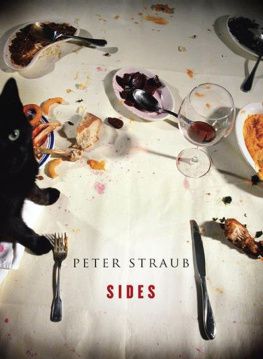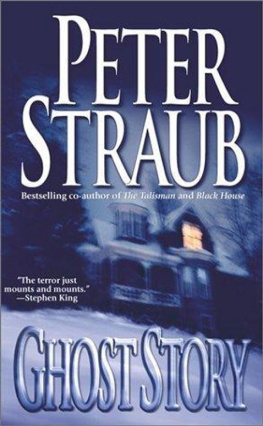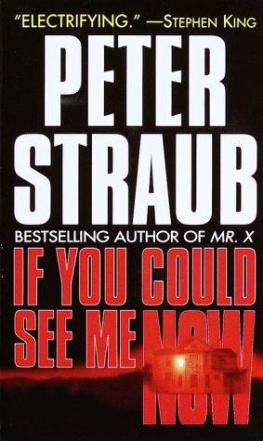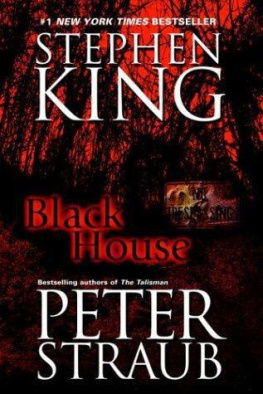SIDES
Peter Straub
CEMETERY DANCE PUBLICATIONS
Baltimore
2007
Copyright 2007 by Peter Straub
All rights reserved. No part of this book may be reproduced in any form or by any electronic or mechanical means, including information storage and retrieval systems, without permission in writing from the publisher, except by a reviewer who may quote brief passages in a review.
Cemetery Dance Publications
132-B Industry Lane, Unit #7
Forest Hill, MD 21050
http://www.cemeterydance.com
First Digital Edition Printing
ISBN: 978-1-58767-250-7
Cover Photograph 2007 by Marni Horwitz
Dust Jacket Design by Michael Fusco
Digital Design by DH Digital Editions
To John Clute
To live is to be someone else.
Fernando Pessoa
Table of Contents
Authors Note
Sides collects most of the non-fiction I have written since moving from an extremely presentable house in Westport, CT, into my brownstone in New York City. Since that move took place in 1985 and it is now 2006, the attentive reader will observe that my non-fictional output has been shamefully slender, especially since a good third of this book consists of the ravings of Putney Tyson Ridge, my self-invented human speed bump and alter ego, and therefore could be considered fiction, if of an odd ventriloquial sort, after all.
It is true, I much prefer writing fiction to non-, and was persuaded to try my hand at the following projects, which tend toward the essayistic, largely because a number of editors and/or publishers dangled projects before me that I found irresistible. A new edition of The Stepford Wives gave me a chance to describe what I thought were really admirable and underappreciated qualities in Ira Levins work; Peter Crowther let me express my appreciation, which has since doubled or perhaps even re-doubled on itself, of Graham Joyces writing; Barry Hoffman encouraged me to think about the reasons I found myself so persuaded by the work of Caitlin R. Kiernan and Poppy Z. Brite; editors at the Modern Library invited me into their comfy, book-lined purview to mull over two great classics of horror; and a terrific guy at the Book-of-the-Month Club, now Bookspan, asked if I would consider doing a piece on Stephen King that would serve as the Introduction to a nice fat volume of his previously uncollected articles and interviews that dealt with the subject of writing. Lawrence Block himself, a friend, asked if I would write a short Intro to a UK small-press edition of his then latest Matt Scudder novel, Hope to Die. He did not ask me to think about the Scudder series as a whole, but thats what I wanted to do, and so I did, temporarily confounding the small press. Once they picked themselves up off the floor, everything worked out fine.
The Fantasy of Everyday Life was my Guest-of-Honor speech at the 1998 International Conference of the Fantastic in the Arts, and can serve as a perfect example of the goofy, homespun surrealism which seems to be my default response to an invitation to express myself in public. As Looking Back, the essay entitled Mom appeared in a book that combined short stories written by mother-son partnerships with essays written by male writers about their mothers.
The frivolity here, Why Electricman Lives in New York was written for an anthology celebrating the twenty-fifth anniversary of New York is Book Country. Two executives of DC comics attended the reading NYIBC had organized for the publication of their handsome volume, and as we filed out of the room, these gentlemen promised to reward me for my efforts on behalf of superheroes with the gift of several boxes of cool stuff. About three weeks later, two huge cartons from DC arrived at the downstairs gate. They had sent me hundreds of graphic novels large and small, earnest and perverse, comic and tragic, sunny and embitteredthe boxes kept me occupied for months. They were right: it was cool stuff.
Peter Straub
Encounters:
Introductions and Afterwords
The Stepford Wives
Introduction to the Perennial Editon
The Stepford Wives , along with almost everything else written by the admirable Ira Levin, does honor to a demanding literary aesthetic that has gone generally unremarked due to its custom of concealing itself, like the Purloined Letter, in plain view. Polished and formal at its core, the aesthetic can be seen in James Joyces Dubliners , the novels of Ivy Compton-Burnett, the work of California Gothic writers like Richard Matheson and William F. Nolan, and in Brian Moores last, drastically underappreciated six novels. Clearly adaptable over a wide range of style, manner, and content, it emphasizes concision, efficiency, observation, accuracy, effect, speed, and the illusion of simplicity. Fiction of this kind rigorously suppresses authorial commentary and reflection in its direct progress from moment to moment. This emphasis on a drastic concision brings with it a certain necessary, if often underplayed, artificiality that always implies an underlying wit, although the individual works themselves may have no other connection to humor. Such fiction possesses the built-in appeal of appearing to be extremely easy to read, since the reader need do no more than float along on the current, moving from a paragraph centered around a sharp visual detail to a passage of dialogue, thence on to another telling detail followed by another brief bit of dialogue, and so on.
In fact, The Stepford Wives is so effortlessly readable that it has been persistently misread, which is to say misunderstood, over the thirty years since its original publication. As a novel that can be devoured nearly in one gulp, its very efficiency deflects attention from the controlled composure of its prose and the jewel-like perfection of its structure. (Readers of popular fiction tend anyhow to ignore the construction of the books that push their buttons and, even more noticeably, to disregard stylistic niceties; gripped by a compelling, or at least exciting, narrative, readers of popular fiction generally overlook the essential qualities of the actual writing that delivers the story, whether it shines or stinks.) Levins prose is clean, precise, and unfussy specifically in order to be as transparent as possible: he wishes to place no verbal static between the words on the page and the events they depict. One great difference between good writing that readers overlook and bad writing that they fail to notice has to do with the number of rewrites and revisions usually required by the former. It isnt at all easy to write clear, declarative prosetransparency evolves from ruthless cutting and trimming and is hard workwhile lumpy, tangle-footed writing flows from the pen as if inspired by the Muse.
Reading The Stepford Wives , we gradually recognize that an inexorable internal timetable lies beneath its action, and that each of the novels hints, breakthroughs, and miniclimaxesthe stages of its heroines progress toward final knowledgehave been exquisitely timed against the imperatives of that underlying schedule. It is like a great clock, ticking away from September 4 to just before Christmas. After moving to the suburban village of Stepford, Joanna Eberhart soon befriends two women refreshingly unlike the house-proud, polite, but seemingly brainless women married to the local men. Bobbie Markowe, short and heavy-bottomed, with small hands and dirty toes, instantly suggests that they try to drum up interest in a local NOW chapter. The only woman in town to display any interest is Charmaine Wimperis, an avid tennis player, who babbles about astrology and her husbands depraved sexual tastes, as evidenced by his recently having presented her with a heavily zippered, whole-body rubber garment. Charmaine moved to Stepford in July, Bobbie in August. Wives in Stepford become Stepford wives after the period of time necessary for their husbands to prepare the ground, or four months after arrival. In November, therefore, Charmaine abruptly tears up her tennis court to install a putting green for her husband, now understood to be a wonderful guy. At this point we do not share the authors awareness that Bobbie has one month left before the dread transformation, Joanna two. Like our heroine, we become aware of the timetable only after Bobbie Markowe returns from a brief marital vacation with enhanced breasts, a slimmer bottom, and a newfound passion for ironing.
Next page











